#Qebhet
Explore tagged Tumblr posts
Photo

Enterramiento en el antiguo Egipto
El enterramiento egipcio es el término común para los rituales funerarios del antiguo Egipto en cuanto a la muerte y el viaje del alma a la otra vida. La eternidad, según la estudiosa Margaret Bunson, "era el destino común de todo hombre, mujer y niño de Egipto" (87), pero no la "eternidad" como una otra vida más allá en las nubes, sino un Egipto eterno que era reflejo de la vida en la tierra.
Sigue leyendo...
3 notes
·
View notes
Photo

Inhumation en Égypte Ancienne
L'inhumation égyptienne est le terme courant pour désigner les rituels funéraires de l'Égypte ancienne concernant la mort et le voyage de l'âme dans l'au-delà. Selon la spécialiste Margaret Bunson, "l'éternité était la destination commune de chaque homme, femme et enfant en Égypte" (87), mais pas une "éternité" au-dessus des nuages, mais une Égypte éternelle reflétant la vie d'un individu sur terre.
Lire la suite...
1 note
·
View note
Text
Deity Archives: Kebechet
Also known as: Qeb-hwt, Qebhet, Khebhut, Kebehut, Kebehwet

Image by Hypernosis on DeviantArt; image cropped by me
Depictions
Often depicted as a snake or an ostrich carrying water, or a starry snake; later her depiction became more humanized as a woman with the head of a snake. She is associated with goddesses Ma'at and Nepthys, and as the daughter of Anpu and Anput.
Epithets
Lost Child
Wandering Goddess
Celestial Serpent
Lady of the cooling water
She of the purification by water
Associations
snakes
the color white
space/stars
day/night
cool water
the Nile River
embalming fluid
libation vessels
Areas of Influence/Invoking
compassion
kindness
cleansing/purification
embalming
reincarnation
spirits of the dead
libations
Overview - History and Mythos
Kebechet is the deification of embalming liquid and has her origins in the Pyramid Texts as the serpent who "refreshes and purifies the pharaoh." Her main role was to provide water and care to the spirits waiting for their mummification to be complete. It is also thought that she played a vital role in the reviving of the soul. A passage written by Richard W. Wilkinson, cited by Joshua J. Mark in his article "Qebhet" on the World History Encyclopedia website, reads that she "refreshes and purifies the heart of the deceased monarch with pure water from four nemset jars and that the goddess helped open the 'windows of the sky' to assist the king's resurrection." She is mentioned frequently in the Book of the Dead.
She was originally a serpent deity worshiped along Nile cities, often recognized as the "celestial serpent" that ruled over both day and night, and the Nile. She never had a very large cult following, but her role has been observed in religious holidays that celebrate the living and the dead such as in the Festival of Wadi which took place between harvest time and the Nile flood. It encouraged the living and the dead to commune.
Kebechet is most known to be the daughter of Anpu (Anubis) and his wife Anput, and helps Anpu in his role as the god of embalming by caring for the dead, purifying them, and fortifying the body against corruption. Her symbolic role may have been to comfort the living that their loved ones are cared for even in death, as well as to encourage care and compassion between the living as they would the dead.
She can be called upon for practices of purification of the body and mind, as well as provide gentle care and company for those dearly departed.
Resources
Hart, George (1986), A Dictionary of Egyptian Gods and Goddesses
Qebhet - World History Ecyclopedia
Kebechet - Sesh Kemet Egyptian Scribe
#deity archives#kebechet#qebhut#kemeticism#kemetic#kemetism#egyptian mythology#egyptian gods#paganblr#witchblr#paganism#deity worship#deity work
14 notes
·
View notes
Text
shoutout to that time we had to make ancient myth-legend crossover oc creatures in class 2 years ago lol. i made a mini pegasus with a snake neck that guards springs and has naiad mamas
Name: Pegazoi; pega (pigí, spring) from Pegasus, zoi (life)
Mix of:
- Qebhet (Egyptian goddess, serpent daughter of Anubis, personification of embalming liquid)
- Pegasus (Winged horse, son of Medusa, said to leave water springs on the earth it struck with his hooves)
- Naiad (Greek water nymphs)
- Grass snakes / Water snakes (Sacred animals in Baltic mythology, common animals in Greece)
Pegazoi are winged white ponies with long, snake-like necks, as well as scales across their bodies. They are much smaller than a regular horse, but reaches the height of three to five with its neck straightened all the way up—although it prefers to keep it relaxed and folded.
They are found living around and just as long as thriving springs with surrounding abundant vegetation, grabbing fruits to eat with its neck and wings.
It is said that the springs that appeared from Pegasus's strikes also come with a single egg similar to that of a water snake's, from which a pegazoi will later hatch.
Often, the naiads of a given spring will tend to the egg and later the foal's needs, and when it is fully grown, the pegazoi returns the favor by becoming the spring's guardian for the rest of its life.
A dying spring may have had its respective pegazoi killed, and likewise, a dying pegazoi's spring may have been heavily polluted.
It is said that pegazoi are a sign of hope; an injured or dying traveller who stumbles upon its spring is treated with the water and nearby plants. If the available resources are not enough, only then will the spring's pegazoi depart with the traveller—dead or alive—on its back, in an attempt to search for any known relatives or acquaintances to return them home to.
Pegazoi are non-venomous, nor do they engage in violence—they simply choose to scare off threats through intimidation or pretending to be a large snake.
In one tale, a traveller stumbles upon a spring and attempts to take a naiad away as his bride. The pegazoi slithers behind the bushes around him in an effort to drive him away, but he stakes it through its scales, leaving a hole in its neck.
The naiads beg for the traveller to stop, to which he realizes that it is a pegazoi rather than a large snake, ensuring it will not try to hurt him. He searches the bushes for the rest of its body, rips off its wings and hooves to immobilize it, then strikes it in the heart with a large branch, killing it.
As he tries to drag the naiad away, she suddenly collapses and dies along with the quickly withering spring behind them. The traveller leaves unharmed as the spring and its surrounding habitat rots away.
1 note
·
View note
Text

Anubis
Egyptian god of death, mummification, embalming, tombs, and burial grounds
Anubis (Egyptian: Anup, Yinepu, or Anpu) was the original King of the Dead until he changed roles and Osiris became King of the Underworld in his place. Because of him being born by Nephthys, Anubis was raised by Isis in order for him and his mother to be protected from Set, who was enraged by Nephthys’ act of adultery against him. When Osiris became the new King of the Underworld, Anubis evolved to be more of a guardian and a psychopomp (one who guides spirits to the Underworld). Anubis is said to have fathered the goddess Qebhet with his wife Anput (Anubis’ feminine counterpart). He is most often depicted as a man with the head of a black Egyptian hound, holding an ankh and a flail (an agricultural tool of a shepherd), or in the complete form of an Egyptian hound. The colour black is significant due to it being associated with rebirth in Ancient Egypt.
The Journey through Duat: Anubis is the god who guards the gateway to Duat (the Underworld) and is one of the deities to assist in judging souls in the Hall of Ma’at, making certain that no one wicked can pass on. It is said that once a mummy was sealed up, Anubis would come with the god Wepwawet and the two of them would guide the soul of the deceased towards the Hall of Ma’at, where they would be judged. While the soul waits for their turn, Qebhet, goddess of cool waters and the daughter of Anubis, is said to come and attend to them. She would be joined by other goddesses such as Nephthys and Serqet, who all comfort and provide for the deceased person.
Once it is their turn, the soul then comes before the fourty-two judges and has to recite the Negative Confessions, claiming to be free or guilty of certain sins (which would change depending on the person). The spirit’s heart would then be placed upon the golden Scales of Truth to be weighed against a feather of Ma’at, the goddess of truth and justice. If the heart was heavier than the feather, the spirit would be given the chance to justify any of their misdeeds, then the judges would deem whether the spirit should be allowed to move on. Anubis is then the one to guide the pure towards the paradise of The Field of Reeds, while the souls of the wicked would have their heart devoured by the goddess Ammit, causing them to be unable to move on and would then be subject to severe punishments.
Other roles: Anubis was also thought to be the inventor and guardian of mummification; watching over the embalming process of every mummy and granting permission to the priests who cut open the bodies. In the myth of Osiris’ death and resurrection, he can be seen assisting Isis and Nephthys in rebuilding and preserving the corpse of Osiris until he could be revived. He is also seen as the god of lost souls, including orphans, and is the one to help guide them towards peace since he is the “shepherd of the dead”. Another role of this god is to watch over the resting places of the dead, punishing anyone who would dare desecrate the area. Thus, Anubis earned the epithet “He Who is Upon the Mountain”, as he was believed to protect the graves and tombs from high above where he could see all. Images of Anubis would be stamped on many of the seals to tombs in the Valley of the Kings, symbolizing the protection of Anubis against raiders and ill-wishers upon the dead. He was even known as the god who had knowledge of the mysteries of the afterlife, including the secrets of magic.
Personal experiences: Anubis is one of the most noble gods I have ever had the honour to meet. He is deeply compassionate, just, diligent, protective, and patient; among the finest of the Netjeru. He is also quite serious and withdrawn, and does not like stupidity or most jokes. Despite what Egyptologists have assumed, Anubis states that he does not actually take the form of a jackal, but of a black Egyptian hound. This is because he guards the dead with stern protection, whereas jackals eat the dead (and he doesn’t look like a jackal at all either). Anubis is also one of the deities who strongly values their own evolution, so he travels through the dark in order to seek the light, and gradually changes for betterment. For this reason, he had stepped down from being the king of the Egyptian Underworld in order to evolve under a different role. It is true that he is the son of Osiris and Nephthys when these two gods had an affair; though despite this, Isis adores Anubis and does not hold anything negative towards him. The goddess Ma’at also claims Anubis to be one of the most wonderful souls in existence due to his noble and generous nature. In addition, Anubis is to be treated with great respect (as all deities should) so do not call him anything insulting or refer to him as a dog, as this can invoke his wrath.
Some of his Epithets:
Guardian of the Scales
Chief Physician
Counter of Hearts
Beautiful Guardian
Chief Healer
Guardian of Souls
Guide of the Two Lands
He Who Checks the Scales
He Who Makes the Corpses
He Who is Hidden
High and Mighty One
Immense Strength
Keeper of the Keys to the Underworld
Lord of the Coffin
Lord of the Underworld
Lord of Purification
Master of the Secrets of the Underworld
He Who is Upon the Mountain
Pharaoh of the Underworld
Ruler of Eternity
Lord of the Sacred Land
Offerings: red dry wine, rum, apple juice, coffee (mochas, Ethiopian), hot chocolate, rye bread, rhubarb, red grapes, figs, lemons, limes, parsley, cooked chicken, curry, hummus, olive oil, dark chocolate, almonds, pinecones, beetroots, eggplants, ivy, chrysanthemum, amaranth, henbane, obsidian, black onyx, smoky quartz, tigers eye, jet, cat skulls, wild dog skulls, bones, fossils, papyrus, linen, leather-bound books, balancing scales, cedar essential oil, bronze incense burners, smyrna resin, black olibanum incense, oud incense, statues of Anubis
#anubis#yinepu#anup#anpu#egyptian gods#egyptian polytheism#kemeticism#netjeru#ancient egypt#deity work
698 notes
·
View notes
Text
Family of Anubis
Raahes — lion warrior, god of war, son of Anubis and Sekhmet
Sekhmet — lioness warrior, goddess of war, sun and revange, wife of Anubis
Qebhet — goddess of embalming and refreshing water, daughter of Anubis

24 notes
·
View notes
Text
Feathers of Truth and Judgement
Ma’at and the Weighing of the Heart: Revisiting the Death of Jin Bubaigawara
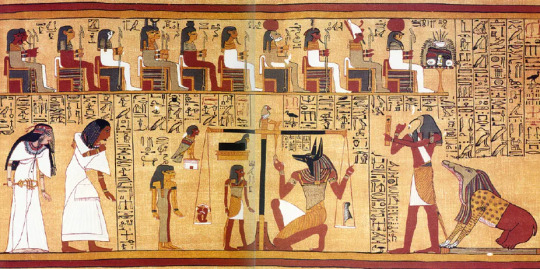
Before I begin, this may not make any sense if you are not familiar with some of what I’ve written about. This is an add on to my post about the interesting similarities between Hawks’ character and the Egyptian God Horus.
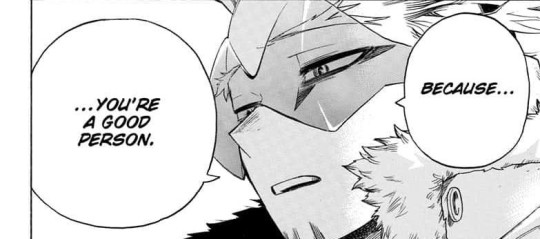
Recap: Tokoyami, Hawks and Endeavor
To recap what I’ve already written previously, there are most definitely Greek/Roman mythological influences in BNHA but there are also Egyptian ones as well most explicitly through Tokoyami Fumikage who basically looks like how Egyptian dieties were portrayed: the head of an animal and the body of a human. Additionally, he has a move named after an Egyptian symbol, the Ankh and his quirk, Dark Shadow is basically a version of the Egyptian concept of the shadow, called shut/swt.
And so I began looking at where else there may be some interesting similarities between BNHA and Egyptian mythology, and eventually started making some connections between Hawks and Horus, and Endeavor and Ra, the Sun God that fit the narrative and symbolism of the two characters. Whether they are mere coincidences or unintentional, I still think that it is interesting to look at and consider. So here we are.
The Egyptian Underworld
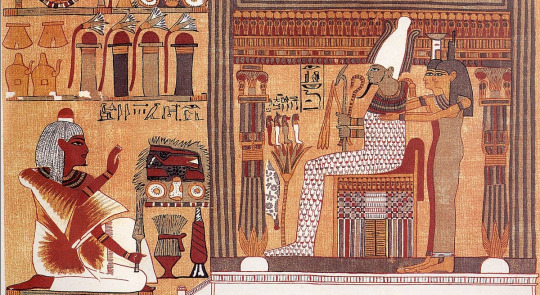
The image above is from the Book of the Dead of Ani. Osiris is depicted sitting with Isis and Nephthys behind him.
In Egyptian mythology, Horus is the son of Osiris and Isis. One of the most famous stories tells of how Osiris’ brother Set takes his life, cuts his body in to several pieces and disperses them across Egypt. A spirit can only travel in to the underworld if they are properly embalmed and buried so Horus and Isis travel around and search for the parts of Osiris’ body. (Depending on the source you are looking at, some say that Isis traveled around with her sister Nephthys, and Horus was born after she resurrects Osiris).
Osiris is resurrected and is able to travel to the underworld where he becomes the Egyptian Lord of the Underworld, and the Judge of the Dead.
Why am I bringing up Osiris? Well his son, Horus is important in relating back to Hawks and Endeavor, but he also leads us to another important deity who I will introduce later. Back when I was gathering information to work with, I noticed that there was some interesting bits about the Afterlife and Judgement process I wanted to add in but to keep it simple, I cut that part out. However, I thought that this was too interesting to not post about.
The Egyptian Afterlife and Judgement
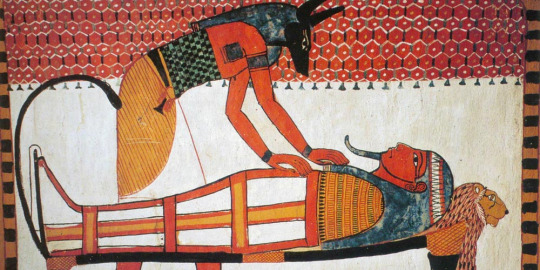
In order to illustrate and explain what the ancient Egyptians believed happened after an individual passed, I included a large excerpt below from the World History Encyclopedia:
In the Egyptian Book of the Dead it is recorded that, after death, the soul would be met by the god Anubis who would lead it from its final resting place to the Hall of Truth.
When it came one’s turn, Anubis would lead the soul to stand before Osiris and the scribe of the gods, Thoth in front of the golden scales. The goddess Ma’at, personification of harmony and balance, would also be present and surrounded by the Forty-Two Judges who would consult with these gods on one’s eternal fate.
The soul would then recite the Negative Confessions in which one needed to be able to claim, honestly, that one had not committed certain sins. The negative declarations, always beginning with “I have not...” or “I did not...”, following the opening prayer went to assure Osiris of the soul’s purity. Each sin listed was thought to have disrupted one’s harmony and balance while one lived and separated the person from their purpose on earth as ordained by the gods.
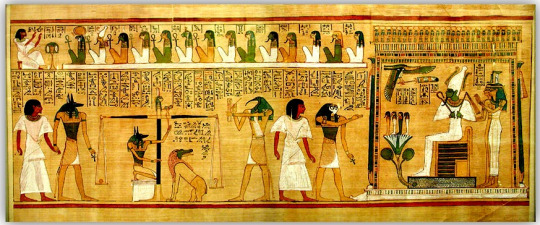
Anubis or Qebhet, his daughter weighs a human’s soul against the weight of the feather of Ma’at while Osiris watches on, Isis and Nephthys behind him.
The ‘heart’ of the soul was handed over to Osiris who placed it on a great golden scale balanced against the white feather of Ma’at, the feather of truth on the other side. If the soul’s heart was lighter than the feather then the gods conferred with the Forty-Two Judges and, if they agreed that the soul was justified the person could pass on toward the Field of Reeds, or paradise.
If the heart proved heavier, it was thrown to the floor of the Hall of Truth where it was devoured by Amenti/Amut. Once the person’s heart is devoured, the individual soul ceased to exist (The ancient Egyptians had no concept that is equivalent to the Judeo-Christian hell).
I’m sure you’ve identified one of the key highlights from the excerpt above that connects directly to Hawks: Ma’at’s feather. Let’s take a closer look at the deity.
The Goddess Ma’at, the Feather of Truth and Judgment
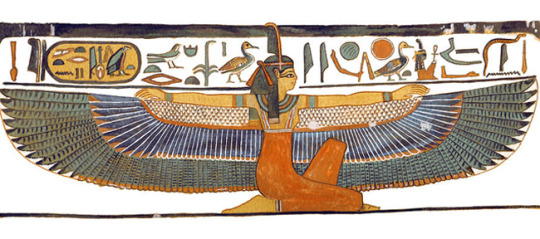
In ancient Egyptian mythology, Ma’at was the goddess of truth, justice, balance and morality. She is often depicted as a woman, with a feather on her head and/or with wings (as depicted above). She was the daughter of the sun god Ra, and the wife of Thoth, the god of wisdom and the moon.
The feather she wears on her head symbolizes her being and presence. It was a representation of balance and order, and it eventually became a hieroglyph for “truth.”
Truth, truth, truth, what does it have to do with Hawks? Well, Hawks is a man who yearns for the truth. He seeks information out, collects it, and analyzes it. When he was first introduced he was shrouded in mystery, people wondered, was he someone to be trusted?
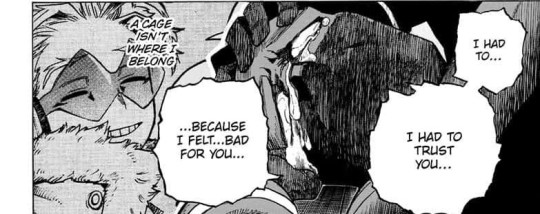
While he could be very blunt with the truth, he was also very deceptive and good at lying. Truth and knowledge is very intertwined with his character design as we see in his name.

Hawks’ true name, gets revealed to us through Dabi: Takami Keigo. According to the BNHA fandom website, Hawks’ surname translates as:
“hawk” (taka 鷹) + “see, visible, idea” (mi 見 )
While his first name translates as:
“disclose, open, say” (kei 啓) + “enlightenment, understanding” (go 悟).
What does Hawks do with all the information and “truths” he gathers? Well, what do we do when we hear or discover the truth?
We make a judgement.
In the court of law, truths and evidences are used to pass judgement. In ancient Egypt, Ma’at was associated with the law and justice.
The ‘Spirit of Ma’at’ was embodied by the chief judge in charge of the Egyptian law courts. He had a dual role, serving as both a priest and working directly in the law courts and justice system. They wore the feather of Ma’at and all other court officials wore small golden images of the goddess as a sign of their judicial authority, also as a symbol that their judgement would be balanced and fair.
Priests drew the Feather of Ma’at on their tongues with green dye, so that the words they spoke were the truth. They would rule on the earthly punishment according to the nature of the law that had been broken.
Punishments included imposing fines, corporal punishment and in extreme cases capital punishment. It was considered a crime against Ma’at if a person engaged in jealousy, dishonesty, gluttony, laziness, injustice, and ungratefulness (ancient origins).
Hawks’ Fierce Wings quirk gives him the ability to turn his feathers in to weapons as we see below which is quite ironic or absurd to think about.

How can a feather condemn someone to death? Well as we saw earlier, in ancient Egypt, one’s fate was determined by the sins they committed in the life they led, and ultimately the weight of their soul compared to that of the Feather of Ma’at.
We are presented with Jin’s backstory that Hawks was most likely able to dig up through his sources which is how he got to his conclusion.
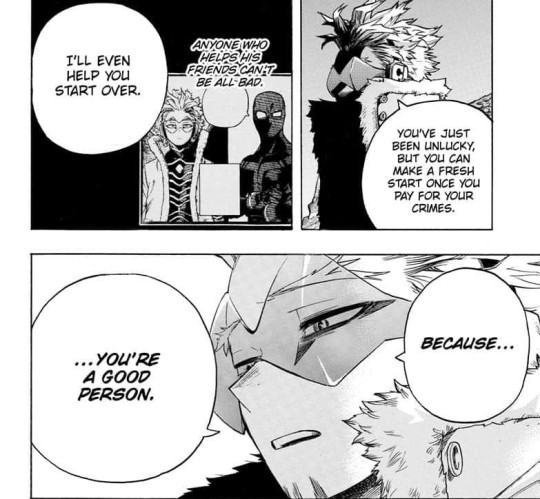
Similar to the process that takes place in the Hall of Truth, Jin’s past and life is reviewed, gone through, and he see how he came to be the person he was. Hawks calls him unlucky. He believes that Jin is a good person, and can be helped.
The problem is, is that heroes are no supposed to act as the judge, jury or executioner. The main role of heroes is to save, and subdue those who are dangerous, passing them on to the police and courts of law: as Hawks was originally intending to do.

But as Jin continues to resist, Hawks changes his intentions.

Their struggle concludes with the death of Jin Bubaigawara.
The Heroes are not Gods

The ancient Egyptians looked to Ma’at to maintain the balance and harmony between good and evil. She represented the truth and morality, and under her guidance those behind the law passed judgement.
However Hawks is not Ma’at. He is not a god. Instead of acting as a servant of the law, Hawks takes it upon himself to embody and become the law. But on the basis of what exactly? It does not matter because he passes judgement himself. He takes his feather and executes Jin based on what he believes is the truth and justice. We are reminded of this objectiveness through the subtitle of Volume 27: One’s Justice.
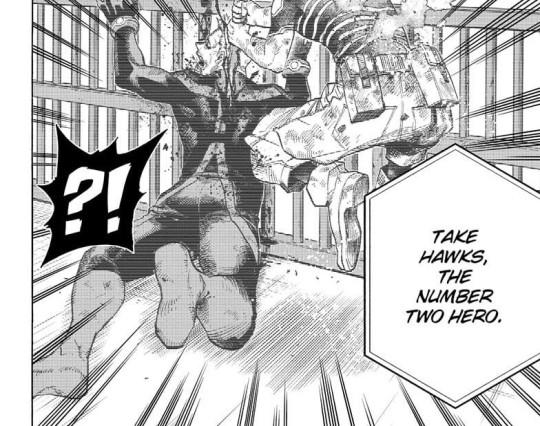
For the longest time, heroes basically were perceived as living gods. Even worshipped, to an extent. Quirks set heroes apart from civilians, placing them on top of the pyramid of power. People lived in a hero saturated society, similar as to how the ancient Egyptians lived with their deities being a part of a great majority of their day to day existences. Despite all the interesting connections and parallels that I can write about, especially with Endeavor and Hawks, it does not change the truth that they are still human: as human as the quirkless. Perhaps their greatest fault was that they acted and lived like gods.
As always, thank you for putting in time to read through this post! I appreciate it. Manga panels throughout this post are from Chapters 264, 265, and 291
#hawks#takami keigo#twice#jin bubaigawara#bnha analysis#mha analysis#bnha meta#mha meta#mythological influences#bnha#mha#bnha spoilers#mha spoilers#luna writes#my post
48 notes
·
View notes
Photo

Egyptian Gods - The Complete List
The gods and goddesses of Ancient Egypt were an integral part of the people's everyday lives for over 3,000 years. There were over 2,000 deities in the Egyptian pantheon, many whose names are well known - Isis, Osiris, Horus, Amun, Ra, Hathor, Bastet, Thoth, Anubis, and Ptah among others - but many more less so who were also important.
Continue reading...
59 notes
·
View notes
Photo

Los dioses egipcios: La lista completa
Los dioses y diosas del Antiguo Egipto formaban parte integral de la vida cotidiana del pueblo, por lo que no es de extrañar que hubiera más de 2000 deidades en el panteón egipcio. Algunos de estos nombres son bien conocidos: Isis, Osiris, Horus, Amón, Ra, Hathor, Bastet, Thot, Anubis y Ptah, mientras que muchos otros no lo son tanto.
Leer más...
0 notes
Photo

Qébéhout
Qébéhout (également connue sous le nom de Kabechet, Khebhut ou Kebechet) est une déesse bienveillante de l'Égypte ancienne. Fille du dieu Anubis, petite-fille de la déesse Nephtys et du dieu Osiris, elle est la personnification de l'eau fraîche et rafraîchissante lorsqu'elle apporte à boire aux âmes des morts dans le Hall de Vérité de l'au-delà.
Lire la suite...
3 notes
·
View notes
Text
Tumbled like It was Stone
tumbled like it was stone by noirshitsuji
“Greetings, heroes of Paris," he says, feeling the eye light up behind him. "I will be Anubis and bring you to trial. I will be Ma'at and bring forth the scales and the feather. I will be Thoth and record your trial, and I will be Osiris and preside over it. My name is Véritier, for I am all 42 judges, but I am not Qebhet or Nepthys or Serket, I will not give you rest as a sign of mercy. If your heart is lighter than this feather, you will be repented, but if not, I will be Amenti and devour your hearts. Now, confess!”
Luka's been on top of it all along. Two years ahead in maturity, ten years ahead in patience– –so how, how is she still eluding him?
Words: 2045, Chapters: 1/1, Language: English
Series: Part 2 of building dynasties out of lost religions
Fandoms: Miraculous Ladybug
Rating: Teen And Up Audiences
Warnings: No Archive Warnings Apply
Categories: F/M
Characters: Luka Couffaine, Marinette Dupain-Cheng | Ladybug, Adrien Agreste | Chat Noir, Juleka Couffaine, Gabriel Agreste | Papillon | Hawk Moth
Relationships: Luka Couffaine/Marinette Dupain-Cheng | Ladybug, Adrien Agreste | Chat Noir/Marinette Dupain-Cheng | Ladybug, Adrien Agreste | Chat Noir & Luka Couffaine, Luka Couffaine & Sass, Juleka Couffaine & Luka Couffaine, Luka Couffaine & Jagged Stone
Additional Tags: Trust Issues, Sense Of Betrayal, Introspection, Settling, Season 4 Episode 1: Truth, Spoilers, Second choice, POV Luka Couffaine, Emotional Maturity, patience - Freeform, Hurt, Angst, Mythology References, Post-Episode: s03 Miracle Queen (The Battle of the Miraculous Part 2), Episode: s02 Le Patineur | Frozer, Episode: s03 Desperada, TV Special: Miraculous World: New York, Jealousy, Repressing Emotions, Oblivious Adrien Agreste | Chat Noir and Marinette Dupain-Cheng | Ladybug, Ancient Egyptian Literature & Mythology
Read Here: https://archiveofourown.org/works/30368652
#AO3 Feed#FanFiction#AO3 Adrienette Plus#💙#🎸#💖#Adrienette Plus#Lukanette#Miraculous Ladybug#♧#R:T#A:Noirshitsuji#Angst
3 notes
·
View notes
Text
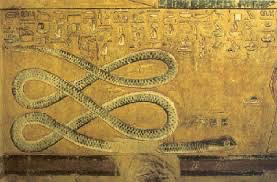
The Egyptians have many spirits or spiritual beings as well as a host of demonic beings often depicted as snakes which probably influenced later Hebrew and Christian demonology, these are as follows:
Afu: Lesser Gods or spirits mentioned in Egyptian texts.
Akebiu: Spirits that wail in the underworld.
Akeneh: A serpentine demon.
Akhem-Sek: A group of celestial beings thought to be the personification of stars.
Amkihiu: The souls of the dead who are granted passage on the boat of the sun God Ra.
Anhefta: A protective spirit of the underworld.
Benen: The guardian of the eighth entrance to Duat.
El Naddaha: A river-nymph and demoness who calls men into the Nile to drown them.
Henmemet: Lesser divine beings.
Hentiu: Spirits of the twelfth area of Duat.
Her-F-Ha-F: The leader of a group of spirits who attempt to capture the souls of the dead in large nets, their name means “fierce fowlers whose fingers are hidden”. Her-F-Ha-F was known to ferry the souls of the dead across the rivers of death and may be related to the Sumerian ferryman Urshanabi.
Hert-Nemmat-Set: A female spirit who resides in the fourth pit of the eleventh area of Duat and punishes the damned.
Hert-Sefu-S: A female spirit who resides in the fifth pit of the eleventh area of Duat and punishes the damned.
Kefi: A guardian of the tenth area of Duat.
Kha-A: A spirit that carries a bow and resides in the tenth area of Duat.
Khaibit: The shades or ghoulish spirits of the dead.
Khnemiu: Four divine beings wearing red crowns found in the eleventh area of Duat.
Maa-Ab: A guardian of the sixth area of Duat.
Mates: A demon who inhabbited the Sheni of the underworld and tore out the hearts of the damned.
Men-Sheta: A spirit personifying the hidden aspects of the Occult or magic who resides in the seventh area of Duat and was depicted as bending over a staff.
Metes: A guardian of the eleventh area of Duat.
Nebt-Khu: A guardian of the eleventh area of Duat. She sits upon a snake with one hand raised over her face. Nebt-Khu never moves and lives on the voices of snakes that spawn from her feet.
Nehata: A spirit that utters words of power in the underworld to restore life to Osiris. Nehata resides in the ninth area of Duat.
Nehebukau: Nehebukau was said to guard the entrance to Duat and was known as the one who caused the binding of the Ka (vital life spark) and the Ba (soul) initiating death. Nehebukau was depicted as a two-headed serpent. When seen as a snake he was seen as having magical power over snake bites and by extension over venoms such as those of scorpions and was therefore sometimes depicted as a son of the scorpion Goddess of healing and protection Selket, this may mean that Nehebukau was invoked to cause death or in attempts to heal poisons magically. As a serpent connected to the life spark and soul Nehebukau could be a form of Egyptian kundalini/serpentine energy mystery.
Nemi: A guardian of the tenth area of Duat.
Ni: A spirit with two bird heads who helps raise up the sun from the underworld each day, Ni carries a paddle and resides in the twelfth area of Duat.
Pai: A guardian of the twelfth area of Duat.
Qebhet: The personification of cool waters said to be a daughter of Anubis.
Senenahemthet: A serpentine demon.
Setcheh: A serpentine demon.
Setheniu-Tep: Four divine beings wearing white crowns found in the eleventh area of Duat.
Set-Qesu: A demon whose name means “crusher of bones” and who occupies the hall of judgement known as Ma’ati.
Stefiu: Four divine beings who occupy the tenth area of Duat and hold the serpent God of chaos Apophis prisoner in chains.
Tcheser-Tep: A serpentine demon.
Thethu: A serpentine demon.
Ufa: A serpentine demon.
Urshu: Spirits whos name means “watchers” likely related to the Sumerian Igigi and later fallen angels.
Wtennu: The spirit of heaven.
9 notes
·
View notes
Text
Qebhet, la Dea della purificazione
Qebhet, la Dea della purificazione
Qebhet (noto anche come Kebehwet, Kabechet o Kebechet ) è una dea benevola dell’antico Egitto . È la figlia del dio Anubi , nipote della dea Nefti��e del dio Osiride , ed è la personificazione dell’acqua fresca e rinfrescante mentre porta da bere alle anime dei morti nella Sala della Verità dell’aldilà. Qebhet non ha mai avuto il proprio culto o area di specializzazione al di là di un consolatore…

View On WordPress
#anima#antichi egizi#Antico Egitto#Anubi#Dea della purificazione#Egitto#Egittologia#Grecia#Hathor#Iside#Kabechet#Karnak#Kebechet#Kebehwet#Libro dei Morti egiziano#Lynn Meskell#Ma&039;at#morte#Nefti#Nilo#Osiride#Qebhet#Quarantadue Giudici#sepoltura#serpente celeste#Set#Tebe#Testi delle Piramidi
1 note
·
View note
Link
by noirshitsuji
“Greetings, heroes of Paris," he says, feeling the eye light up behind him. "I will be Anubis and bring you to trial. I will be Ma’at and bring forth the scales and the feather. I will be Thoth and record your trial, and I will be Osiris and preside over it. My name is Véritier, for I am all 42 judges, but I am not Qebhet or Nepthys or Serket, I will not give you rest as a sign of mercy. If your heart is lighter than this feather, you will be repented, but if not, I will be Amenti and devour your hearts. Now, confess!”
Luka’s been on top of it all along. Two years ahead in maturity, ten years ahead in patience– –so how, how is she still eluding him?
Words: 2045, Chapters: 1/1, Language: English
Series: Part 2 of building dynasties out of lost religions
Fandoms: Miraculous Ladybug
Rating: Teen And Up Audiences
Warnings: No Archive Warnings Apply
Categories: F/M
Characters: Luka Couffaine, Marinette Dupain-Cheng | Ladybug, Adrien Agreste | Chat Noir, Juleka Couffaine, Gabriel Agreste | Papillon | Hawk Moth
Relationships: Luka Couffaine/Marinette Dupain-Cheng | Ladybug, Adrien Agreste | Chat Noir/Marinette Dupain-Cheng | Ladybug, Adrien Agreste | Chat Noir & Luka Couffaine, Luka Couffaine & Sass, Juleka Couffaine & Luka Couffaine, Luka Couffaine & Jagged Stone
Additional Tags: Trust Issues, Sense Of Betrayal, Introspection, Settling, Season 4 Episode 1: Truth, Spoilers, Second choice, POV Luka Couffaine, Emotional Maturity, patience - Freeform, Hurt, Angst, Mythology References, Post-Episode: s03 Miracle Queen (The Battle of the Miraculous Part 2), Episode: s02 Le Patineur | Frozer, Episode: s03 Desperada, TV Special: Miraculous World: New York, Jealousy, Repressing Emotions, Oblivious Adrien Agreste | Chat Noir and Marinette Dupain-Cheng | Ladybug, Ancient Egyptian Literature & Mythology
0 notes
Photo

Anubis
Anubis (also known as Inpu, Inpw, Anpu) is the Egyptian god of mummification, funerary rites, guardian of tombs, and guide to the afterlife as well as the patron god of lost souls and the helpless. He is one of the oldest gods of Egypt, most likely developed from the earlier jackal god Wepwawet with whom he is often confused.
Anubis' image is seen on royal tombs from the First Dynasty of Egypt (c. 3150-2890 BCE) but it is certain he had already developed a cult following prior to this period in order to be invoked on the tomb's walls for protection. He is thought to have developed in response to wild dogs and jackals digging up newly buried corpses at some point in the Predynastic Period in Egypt (c. 6000-3150 BCE) as the Egyptians believed a powerful canine god was the best protection against wild canines.
Depiction & Associations
He is depicted as a black canine, a jackal-dog hybrid with pointed ears, or as a muscular man with the head of a jackal. The color black was chosen for its symbolism, not because Egyptian dogs or jackals were black. Black symbolized the decay of the body as well as the fertile soil of the Nile River Valley which represented regeneration and life. The powerful black canine, then, was the protector of the dead who made sure they received their due rights in burial and stood by them in the life after death to assist their resurrection.
He was known as "First of the Westerners" prior to the rise of Osiris in the Middle Kingdom (2040-1782 BCE) which meant he was king of the dead (as "westerners" was the Egyptian term for departed souls in the afterlife which lay westward, in the direction of sunset). In this role, he was associated with eternal justice and maintained this association later, even after he was replaced by Osiris who was then given the honorary title "First of the Westerners".
In earlier times, Anubis was considered the son of Ra and Hesat (associated with Hathor), but after his assimilation into the Osiris myth he was held to be the son of Osiris and his sister-in-law Nephthys. He is the earliest Egyptian deity depicted on tomb walls and invoked for protection of the dead and is usually shown tending to the corpse of the king, presiding over mummification rituals and funerals, or standing with Osiris, Thoth, or other gods at the Weighing of the Heart of the Soul in the Hall of Truth in the afterlife.
A popular image of Anubis is the standing or kneeling man with the jackal's head holding the golden scales on which the heart of the soul was weighed against the white feather of truth. His daughter is Qebhet (also known as Kabechet) who brings cool water to the souls of the dead in the Hall of Truth and comforts the newly deceased. Anubis' association with Nephthys (known as "Friend to the Dead") and Qebhet emphasizes his long-standing role as protector of the dead and a guide for the souls in the afterlife.
Continue reading...
141 notes
·
View notes
Photo

Dieux Égyptiens - une Liste Complète
Les dieux et les déesses de l'Égypte ancienne faisaient partie intégrante de la vie quotidienne de la population. Il n'est donc pas surprenant qu'il y ait eu plus de 2 000 divinités dans le panthéon égyptien. Les noms de certaines de ces divinités sont bien connus : Isis, Osiris, Horus, Amon, Râ, Hathor, Bastet, Thot, Anubis et Ptah, mais beaucoup d'autres le sont moins.
Lire la suite...
4 notes
·
View notes